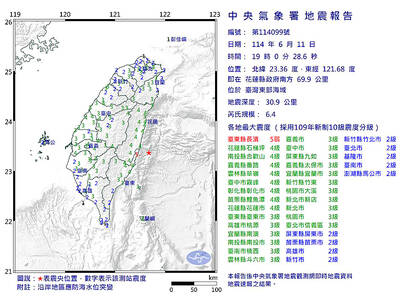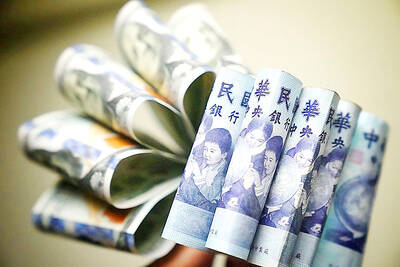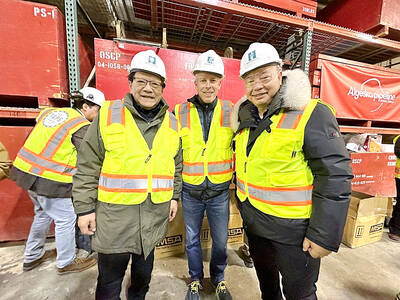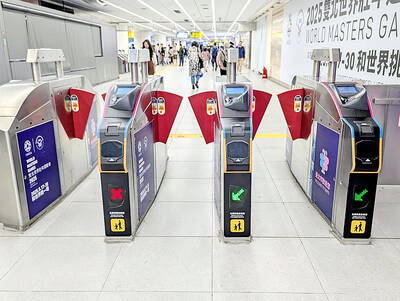Three international fashion brands with a strong presence in Taiwan have been commended in Greenpeace’s 2016 Detox Catwalk report for their efforts to eliminate hazardous chemicals from their clothes, the group said yesterday.
The three brands — Zara, Benetton and H&M — are ahead of the field, leading the fashion industry toward a toxic-free future by setting credible timelines, taking concrete action and achieving on-the-ground implementation, Greenpeace said.
This year, the organization assessed 19 fashion and sportswear brands worldwide based on their efforts to achieve transparency across their supply chains by publishing their wastewater data and their lists of suppliers and seeking to eliminate hazardous chemicals from their products.
Zara, Benetton and H&M, which all have several stores in Taiwan, were named “Detox Avant-Garde” enterprises this year, it said.
The report showed that the other 16 fashion and sportswear brands assessed this year were not making fast enough progress.
Greenpeace said 12 of the Detox committed brands, including Mango, Adidas, Levi’s, Valentino and Puma, were still in “evolution mode” and needed to improve their performance in at least two of the three key assessment areas.
Greenpeace said the other four brands, including Esprit and Nike, were put in the “faux pas” category because they have not accepted individual responsibility for their hazardous chemical pollution or implemented the urgent steps needed to achieve the goal of eliminating hazardous chemicals from their products by 2020.
Chen Ling-yao (陳玲瑤), manager of Greenpeace’s pollution prevention project, said that more than 76 international brands and supply chains had committed to publishing their wastewater data and setting a timetable for phasing out the use of toxic chemicals in their products.
The publication of the Detox Catwalk is a reminder to those enterprises to remain committed to eliminating chemical pollution, Chen said.

A magnitude 6.4 earthquake struck off the coast of Hualien County in eastern Taiwan at 7pm yesterday, the Central Weather Administration (CWA) said. The epicenter of the temblor was at sea, about 69.9km south of Hualien County Hall, at a depth of 30.9km, it said. There were no immediate reports of damage resulting from the quake. The earthquake’s intensity, which gauges the actual effect of a temblor, was highest in Taitung County’s Changbin Township (長濱), where it measured 5 on Taiwan’s seven-tier intensity scale. The quake also measured an intensity of 4 in Hualien, Nantou, Chiayi, Yunlin, Changhua and Miaoli counties, as well as

Credit departments of farmers’ and fishers’ associations blocked a total of more than NT$180 million (US$6.01 million) from being lost to scams last year, National Police Agency (NPA) data showed. The Agricultural Finance Agency (AFA) said last week that staff of farmers’ and fishers’ associations’ credit departments are required to implement fraud prevention measures when they serve clients at the counter. They would ask clients about personal financial management activities whenever they suspect there might be a fraud situation, and would immediately report the incident to local authorities, which would send police officers to the site to help, it said. NPA data showed

ENERGY RESILIENCE: Although Alaska is open for investments, Taiwan is sourcing its gas from the Middle East, and the sea routes carry risks, Ho Cheng-hui said US government officials’ high-profile reception of a Taiwanese representative at the Alaska Sustainable Energy Conference indicated the emergence of an Indo-Pacific energy resilience alliance, an academic said. Presidential Office Secretary-General Pan Men-an (潘孟安) attended the conference in Alaska on Thursday last week at the invitation of the US government. Pan visited oil and gas facilities with senior US officials, including US Secretary of the Interior Doug Burgum, US Secretary of Energy Chris Wright, Alaska Governor Mike Dunleavy and US Senator Daniel Sullivan. Pan attending the conference on behalf of President William Lai (賴清德) shows a significant elevation in diplomatic representation,

The Taipei MRT is to begin accepting mobile payment services in the fall, Taipei Rapid Transit Corp said on Saturday. When the company finishes the installation of new payment units at ticketing gates in October, MRT passengers can use credit cards, Apple Pay, Google Pay and Samsung Pay, the operator said. In addition, the MRT would also provide QR payment codes — which would be compatible with Line Pay, Jkopay, iPass Money, PXPay Plus, EasyWallet, iCash Pay, Taiwan Pay and Taishin Pay — to access the railway system. Currently, passengers can access the Taipei MRT by buying a single-journey token or using EasyCard,